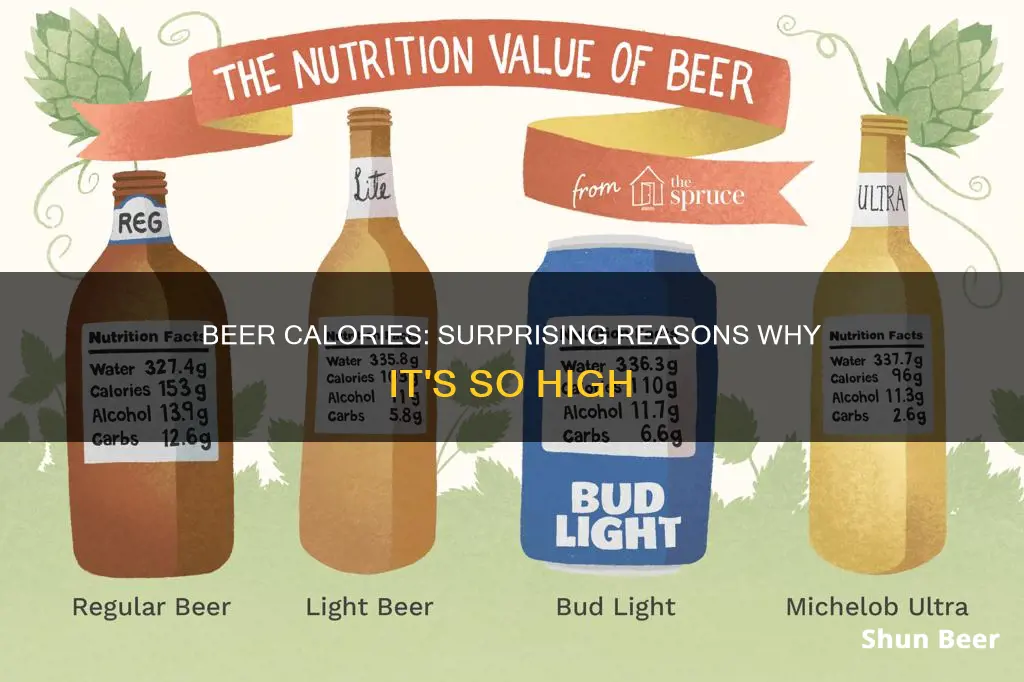
Beer is an alcoholic drink made from grain, such as barley, wheat or rye, that has been fermented with yeast. The calorie content of beer depends on its alcohol content—the more alcohol it contains, the more calories it has. A typical 12-ounce beer has around 150 calories, which is comparable to a can of Coke. Beers with higher alcohol content, such as IPAs, can contain 200 to 300 calories. On the other hand, light beers have fewer calories, ranging from 50 to 100 calories per 12-ounce serving.
| Characteristics | Values |
|---|---|
| Calories in beer | 43 kcal per 100 ml for a classic beer with 5% alcohol |
| Calories in alcohol | 7 kcal per gram |
| Calories in carbs | 4 kcal per gram |
| Calories in fat | 9 kcal per gram |
| Beer with higher alcohol content | More calories |
| Beer with added sugar | More calories |
| Beer with higher carbs | More calories |
| Beer with lower alcohol content | Fewer calories |
| Beer with lower carbs | Fewer calories |
| Beer with lower sugar | Fewer calories |
| Beer belly | Caused by excess calorie consumption, the body's inability to burn fat, and phytoestrogen content |
| Beer belly affected by | Amount of alcohol consumed, frequency of consumption, and gender |

Alcohol content
The calorie content of beer depends on its alcohol content. The more alcohol a beer contains, the more calories it contains. Alcohol contains about seven calories per gram, which is higher than carbs and protein (four calories per gram) but lower than fat (nine calories per gram).
A typical 12-ounce beer has as many calories as a can of Coke (140). Some beers have twice that amount. A beer with an average level of alcohol content of around 5% has about 43 kilocalories for 100ml. A 12-ounce serving of light beer typically has 50 to 100 calories, while a regular 5% alcohol beer has around 150 calories. Very-low-alcohol beers (2% to 3% alcohol) start at around 60 calories for 12 ounces. Most lights (4% alcohol) have about 100 calories.
Heavy hitters (7% to 11% alcohol) like regular IPAs, double or imperial IPAs, and Belgian-style Trippels pack 200 to 300 calories. A lower-alcohol “session” IPA cuts that to 140 or so. Newer "lo-cal" IPAs like Dogfish Head Slightly Mighty have as little as 100 calories.
The strength of a beer depends on the amount of alcohol it contains, which is measured as alcohol by volume (ABV). The alcohol content of beer is usually 4–6% but can range from very weak (0.5%) to exceptionally strong (40%). Beers with a higher alcohol content also contain more calories.
The Dietary Guidelines for Americans includes up to one serving a day of alcohol for women and two servings a day for men. A serving is defined as 12 ounces of beer that is five percent ABV. Specialty brewer beers may contain seven percent ABV, so a serving size is a smaller eight ounces.
Calories in Stella Artois: Nutritional Breakdown of Beer
You may want to see also

Carbohydrates
The calories in beer come from the starches and sugars from unfermented grains used in the brewing process. The grains are heated, dried, cracked, and soaked in water to release their sugars, resulting in a sugary liquid called "wort." The wort is then boiled, and hops are added for flavouring.
The amount of carbohydrates in beer varies depending on the type and maker. A 12-ounce serving of light beer typically contains 50 to 100 calories, while a regular beer has about 150 calories. The alcohol content of beer usually ranges from 4% to 6% but can be as low as 0.5% in non-alcoholic beers or as high as 40% in exceptionally strong beers.
The more alcohol in a beer, the more calories it contains. This is because alcohol has about seven calories per gram, which is almost as many as fat (nine calories per gram) and more than carbs and protein (four calories per gram). Therefore, beers with higher alcohol content, such as heavy hitters like regular IPAs, double or imperial IPAs, and Belgian-style Trippels, can pack 200 to 300 calories per serving.
When it comes to calories, light or very low-alcohol beers (2% to 3% alcohol) like Miller 64 start at around 60 calories for a 12-ounce serving. Most light beers (4% alcohol) have about 100 calories, while an average 5% alcohol brew like Budweiser is around 150 calories.
Michelob Beer Calories: What's the Count?
You may want to see also

Beer vs other drinks
The number of calories in beer depends on its alcohol content and ingredients. Beers with higher alcohol levels and added sugar have more calories. A classic beer with an average alcohol content of 5% has about 43 kilocalories for 100ml. Alcohol itself contains 7 calories per gram.
Compared to other alcoholic drinks, beer is one of the drinks with the least calories. Some other low-calorie alcoholic drinks are cider, prosecco, wine, champagne, and sangria. Absinthe, sambuca, baileys, pastis, amaretto, and gin are some of the drinks with the highest calories. For example, a regular beer contains 43kcal per 100ml, while absinthe has 348kcal per 100ml.
A standard 7-ounce mixed drink and 12-ounce beer usually have the same number of calories and will likely contribute to the same amount of weight gain. However, pure spirits alone contain fewer calories and carbohydrates. A standard 12-ounce beer with 5% ABV typically has around 150 calories, while a shot of liquor contains 98 calories.
A typical pint of lager contains 180 calories, the equivalent of a slice of pizza. Stouts and ales can be as calorific as a whole bagel (around 250 calories), and a pint of cider can contain as many calories as a sugared doughnut (about 216 calories). Two large glasses of red wine make up almost 20% of a man's daily recommended intake of 2,500 calories, or 25% of a woman's (2,000 calories).
Calories in Icehouse Beer: Nutritional Breakdown and Health Facts
You may want to see also

Weight gain
Beer is an alcoholic drink made from grain, such as barley, wheat, or rye, that has been fermented with yeast. The nutritional value of beer varies by type, but a 12-ounce (355-millilitre) serving of regular beer with approximately 4% alcohol content contains around 153 calories. Beer is high in carbohydrates and alcohol but low in almost all other nutrients. The calorie content of beer depends on its strength—the more alcohol it contains, the more calories it contains.
Drinking beer can cause weight gain, including belly fat. Men are at a higher risk of developing a "beer belly" than women due to several factors, including drinking more heavily, storing fat around the belly when they gain weight, and the effect of alcohol on testosterone levels. However, it is important to note that the link between beer consumption and weight gain is not limited to men.
There are several ways in which beer may contribute to weight gain:
- Increased Calorie Intake: Beer contains a significant number of calories, similar to a soft drink. Additionally, alcohol can increase appetite, leading to excess calorie consumption.
- Inhibition of Fat Burning: Alcohol consumption prevents the body from burning fat. This is because the body prioritizes the breakdown of alcohol over other sources of fuel, including stored fat.
- Phytoestrogen Content: The flowers of the hop plant, used to flavour beer, are high in phytoestrogens. These plant compounds can mimic the female sex hormone estrogen and may increase the risk of storing belly fat, particularly in men.
While moderate consumption of one beer per day or less is not typically linked to significant weight gain, heavy drinking or regular binge drinking can lead to a high risk of belly fat accumulation and other serious health problems. To minimize the risk of weight gain, it is important to keep alcohol intake within recommended limits and maintain a healthy, active lifestyle.
Low-Calorie Beers: Less Than 100 Calories, More Taste
You may want to see also

Nutritional value
Beer is an alcoholic drink made from grain, such as barley, wheat or rye, that has been fermented with yeast. The nutritional value of beer varies by type, but a 12-ounce (355-millilitre) serving of regular beer, with approximately 4% alcohol content, contains 140 to 153 calories. Beer generally has about 150 calories, whereas light beer calories range from 50 to 100 calories for a 12-ounce serving. Beers with stronger alcohol levels have more calories, and beers with added sugar also have extra calories. A classic beer with an average level of alcohol content of around 5% has about 43 kilocalories for 100 millilitres. Note that alcohol itself contains calories, and 1 gram of alcohol has 7 calories.
Beer is high in carbohydrates and alcohol but low in almost all other nutrients. It also contains small amounts of micronutrients, including sodium, potassium and magnesium. However, it’s not a particularly good source of these nutrients, as you would need to drink massive amounts to satisfy your daily requirements.
Compared to other alcoholic drinks, beer is one of the drinks with the least calories. For example, a regular beer contains 43 kilocalories per 100 millilitres, while absinthe has 348 kilocalories per 100 millilitres. So, when watching your weight, beer is one of the best choices—as long as it is consumed in moderation.
Calories in Somersby Cider Beer: Nutritional Breakdown
You may want to see also
Frequently asked questions
Beer has a lot of calories because alcohol contains about seven calories per gram, which is higher than carbs and protein (four calories per gram) but lower than fat (nine calories per gram). Beers with stronger alcohol levels have more calories, and beers with added sugar also have extra calories.
The number of calories in beer varies depending on the type of beer and the maker. A classic beer with an average level of alcohol content of around 5% has about 43 kilocalories for 100ml. A typical 12-ounce beer has around 150 calories, which is similar to a can of Coke. Some beers have twice that amount.
Beer is one of the alcoholic drinks with the least calories. Alcoholic beverages with higher calories include absinthe, sambuca, Baileys, pastis, amaretto, and gin. Beer also has fewer calories than spirits and wine, which have around 97-125 calories for a similar serving size.
If you are concerned about weight gain, you can try drinking in moderation, drinking at your own pace instead of in rounds, drinking with a meal, pacing yourself by taking small sips, and avoiding binge drinking.







